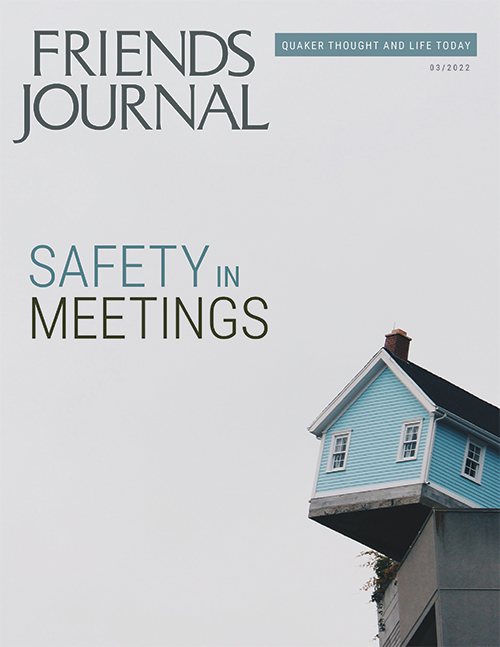Preparing and Responding to Disclosures
Whether you expect it or not, sooner or later you will face a disclosure of trauma from someone in your life. The more openly you stand with victims of interpersonal violence, the more frequently you will experience the sharing of these stories. When people trust you enough to disclose trauma to you, they are honoring you with a most sacred gift: the gift of their vulnerability and truth. Too often we do not know what to say, or say something that is meant with the best of intentions but which leaves a harmful impact in the wake of our words. As meetings, we may fear social and legal ramifications from disclosures and thus try to minimize or rationalize them away. Handling another’s trauma story—no matter what kind, when it happened, or between whom—is an art. Like any art, it takes guidance and practice to work through these moments effectively.
Educating All
First, let’s look at the one-on-one interpersonal response. Even if someone in our meeting is leading conversations around trauma or is designated with maintaining safety and compliance, it is vital that every member have at least a foundational knowledge of how to handle disclosures with care. In my years working with both large and small organizations on sexual misconduct prevention and restorative practices, the greatest gaps in education that I have observed is in leadership and in community members, who are the people most likely to receive a first report. The majority of cases of interpersonal violence are never reported to authorities. When people do speak out, it is often in whispers among fellow members and personal friends. Once they receive an affirming response from a close connection, then they are more open to the idea of contacting someone in a leadership position (clerks, etc.). That first response from someone with whom they feel safe enough to touch the waters of openness is critical. If they feel dismissed, shutdown, or not believed, then they will likely not share their pain with anyone else.
Those that do report their abuse will often then leave their meeting or faith identity completely. The intertwining of violence, trauma, and religion are so closely connected that to reject the experience of one means divorcing one’s self from the others. This can lead to the survivor losing so much more than their sense of physical safety. Religious community is intrinsic to many people’s sense of self, ethnic identity, familial relationships, and belonging. The perpetrator desecrates not only the physical and emotional well-being of the victim but also their connection to God and faith. To lose not only one’s sense of innocence, agency, and well-being but also the connection to spirituality makes it a crime unlike any other.
I have worked with numerous survivors in their 60s and 70s who were telling of their childhood trauma for the first time. Every time they had previously started a conversation about the topic with people they trusted, they saw signs that their honesty about their experience would not be well-received. This leaves community members to sit in the silence of their private pain. It also allows those who are causing harm to remain in a position in which they can continue to perpetuate further violence. By educating all meeting members on topics such as trauma-informed care for faith communities, what to say and not say when someone discloses, best practices for supporting victims, myths on false reporting, and atonement for offending parties, we can bridge the most common gaps in meeting the needs of survivors.
The intertwining of violence, trauma, and religion are so closely connected that to reject the experience of one means divorcing one’s self from the others. This can lead to the survivor losing so much more than their sense of physical safety.
Leadership Education
As Quakers we are all leaders, the ministers to the ministers. Being such, we all have a responsibility to take up the mantle and lead the way to a holistic approach to responding to complaints of harassment, microaggressions, and assault. Faith leaders and spiritual communities are in a unique position to turn the tide from being a place where abusers can hide to a home for transformational healing. Across all major faith groups, there stands a professed foundational belief in hope, healing, and justice. Faith communities already offer many services that could be used to provide a healing environment in pastoral care, youth education, and prevention. Yet in order to do this, we must first look at what our Quaker faith is asking of us, sit with the truth of the harm that has been done, and strategically plan our course of action for longitudinal growth.
A Faithful Response to Doers of Harm
As communities rooted in faith, we are posed with the additional responsibility and challenge to see the perpetrator of harm as a child of God. Misused, this idea can cause us to look away from our responsibility to create an environment of accountability. The idea utilized mindfully allows for spirit-led spaces to offer victims a clearer voice, and for atonement to be integrated in ways that avoid performative punishment.
When we ask for repentance, we must reflect on the root of the biblical concept in the Torah: teshuva. Teshuva is the Hebrew word that is most commonly translated as “to repent.” When Christ asks his community to repent, he is asking them to do teshuva. The literal translation of teshuva is “to return.” It means to return to the path of righteousness. This gives us great insight into repentance that grows from more than simply feeling bad and denouncing our past behavior; teshuva is transformation. It requires the harm that has been caused to be fully acknowledged. It puts the full responsibility on the path-diverter for having taken the direction that led to the self-justification of their actions. Teshuva challenges us to define what the righteous path is and what it would look like to stay on this course.
Teshuva is not just for the individual who has acted egregiously, it is also for the community that has, intentionally or not, allowed the harm to go on. If we have let things go that should have been addressed or if we chose to ignore past reports of damage incurred, now is the moment for our communal atonement. This is done by first identifying what the righteous path is: how do we show up as a faith community in a way that directly prevents and responds to the spectrum of harm? In what ways have our social norms and scripts shutdown those seeking help in our past? What would the alternative path look like in its policies, procedures, and behaviors?
Restoring Justice
Restorative justice is a term that encompasses a wide variety of tools for responding to harm in ways that are thoughtful, sustainable, and transformative. The term restorative justice originated in the 1970s as part of an interdisciplinary approach to addressing crime and punishment outside of a punitive context. As Latimer, Dowden, and Muise state in The Effectiveness of Restorative Justice (2005), “The fundamental premise of the restorative justice paradigm is that crime is a violation of people and relationships rather than merely a violation of law.”
Though the term restorative justice is relatively new in a colonized Western context, the concept itself is ancient and cross-cultural. In North America, numerous Indigenous communities utilized practices for addressing harm that focused on accountability and restoring inter-tribal and kinship relationships. Practices still used in Indigenous systems today, such as Navajo peacemaking, have laid the foundation for the re-imagining presently being conducted in criminal justice systems. By looking at the psychology of the harm-doer, the individual(s) who have received the harm, and the community that is impacted, these principles go beyond the Western legalistic concept of “informal resolutions,” as they seek to find meaningful solutions that address the roots of harm, not just its fruits.
Restorative justice thus encompasses much more than the pursuit of justice: instead it seeks to knit together the tears in relational fabrics. This includes looking at restorative processes that are enacted through restorative practices, which are underlined by restorative values. In order for these processes to take place, there must be three components in place: voluntary participation, truth-telling, and facing the impact of offenses. No one can be forced into being an active participant in a restorative process, though components of restorative justice can be utilized even when certain parties are not willing to be involved. The truth must be told without the need to excuse, justify, or rationalize the harm that has occurred, a process that requires the harm-doer to face the totality of their actions.
Preventing interpersonal violence in faith communities is not a special interest issue. It should not be a topic that is seldom addressed, but one that is part of an integrated and ongoing conversation within the community.
Moving Forward in the Light
Having facilitated restorative justice practices in legal spheres with faith communities and in informal environments where harm has been done, it is most important that we not shy away from these conflicts. Being a historical peace church, we may see bringing these painful truths to the light as dangerous, and in order to maintain peace, we become conflict avoidant. True peace includes holding space for lamenting, crying, grieving, visceral reactions, and not trying to sanitize them to fit our needs.
Preventing interpersonal violence in faith communities is not a special interest issue. It should not be a topic that is seldom addressed, but one that is part of an integrated and ongoing conversation within the community. This begins with educating faith leadership on understanding, identifying, and addressing misconduct across the continuum of harm. This requires the unlearning of rape-acceptance beliefs, such as victim-blaming and slut-shaming, which are often compounded by religious false doctrine around sexuality and sin. Pastors, priests, rabbis, imams, and the like have to live these messages in order for their community to have a chance at transformation. This includes looking at the ways that we treat those who report, and understanding the survivor experience in its complex wholeness. Only when these cornerstones are in place, can we start to build a restorative approach to justice that can be actualized.
The first step on this journey is to choose to look past our fears. Addressing harm that has been done—across places and generations—will involve conflict, but this is not a reason to hide from this work. The more I work with conflict, the more I’m aware that this is where I find God is most fully present. In engaging in this hard work, we see fruits that are beyond any that can be found through alternative avoidant behaviors. We become the anchors in a world that hungers for healing and justice.




Comments on Friendsjournal.org may be used in the Forum of the print magazine and may be edited for length and clarity.